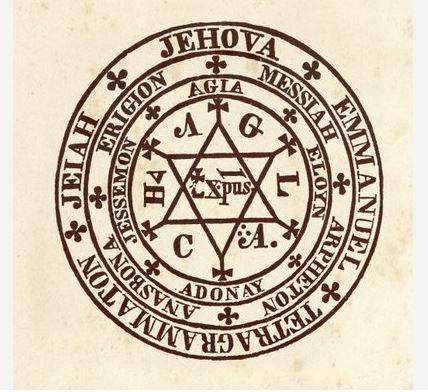About Occult Philosophy

The "Occult Philosophy" by Heinrich Cornelius Agrippa von Nettesheim is a comprehensive work that represents a synthesis of the esoteric disciplines of his time and is considered one of the most influential works in Western magic and esotericism. Agrippa, a 16th-century German physician, jurist, and philosopher, summarized the teachings of magic, astrology, alchemy, Kabbalah, and Hermeticism in this work, laying the foundations for many esoteric traditions that later became popular in the West.
Originally published as "De Occulta Philosophia" (The Occult Philosophy) in 1531, the work is divided into three volumes and covers various aspects of the magical sciences. Agrippa's philosophy establishes the connection between the spiritual and physical worlds and argues that through an understanding of natural laws and cosmic forces, humans can gain access to divine wisdom and magical power.
🌿 Overview of Agrippa's "Occult Philosophy":
The "Occult Philosophy" is a profound and far-reaching work that not only summarizes the occult disciplines of the time, but also presents a spiritual vision of the universe in which humanity is understood as a microcosm of the macrocosm. Agrippa is guided by the principles of Hermeticism and integrates ideas from Platonism, Aristotelianism, Kabbalah, and Christian mysticism.
The three books of "De Occulta Philosophia":
Book I: The Nature of Things (Magic of Nature)
The first book covers the fundamental principles of the magical world order and explains how the forces of nature interact with each other. Agrippa emphasizes that all things in the universe are interconnected and that magical interventions must occur in harmony with natural laws and principles. The four elements (fire, water, earth, and air) and the influence of the planets play an important role.
Natural magic is understood here as a way to understand natural forces and utilize them for spiritual or practical purposes. Magic is viewed as a natural force based on the principles of harmony and cosmic order.
Book II: Celestial Magic (Astrology)
The second book focuses on cosmic forces and the influence of the stars, planets, and celestial bodies on life on Earth. Agrippa explains how, through an understanding of astrology and cosmic influences, humans are able to influence their own lives and destinies.
Astrology is presented as a scientific and magical discipline that enables practitioners to understand cosmic flow and achieve positive results through deliberate actions in harmony with planetary forces. It is not merely about fortune-telling, but rather about a deep understanding of the magical powers of the universe and their application.
Book III: Intelligible Magic (Theurgy)
The third book deals with theurgic magic, considered the highest expression of magic. Here, the goal of magic is no longer limited to influencing the natural world and fate, but rather, divine contact is sought.
Theurgy is the attempt to reach the divine spirit through ritual practices and prayers and to communicate with divine beings, especially angels and higher spiritual entities. The goal of theurgy is to elevate the soul and connect it with higher, divine realms.
🌌 Key principles of Agrippa's occult philosophy:
Microcosm and Macrocosm:
A central aspect of Agrippa's philosophy is the connection between microcosm and macrocosm. Humans, as a microcosm, reflect the universe, understood as a macrocosm. Everything in the universe is interconnected, and by understanding the laws of nature and learning magical practices, humans can influence the forces of the cosmos in their own lives.
Magic as a natural force:
Agrippa understands magic as a natural and scientific discipline based on the principles of harmony and universal law. He rejects the idea that magic is supernatural or incomprehensible. Instead, he sees it as an art derived from the natural laws of the world.
The role of the stars and the planets:
The cosmic forces and the influences of celestial bodies are crucial for Agrippa to understand proper magical practice. Astrology therefore plays a central role in his occult philosophy, as it helps determine the right times for magical acts and influences people's destinies.
The importance of Kabbalah and numerology:
Agrippa integrates
He considers Kabbalah and numerology an important part of his occult philosophy. He believes that the Hebrew letters and numbers have a deeper meaning and serve as keys to hidden truths. Numerical symbolism is of great importance for deciphering the cosmic order.
Theurgy and Spiritual Elevation:
The highest goal of Agrippa's magical practice is divine union and elevation of the soul. Theurgy is the process by which the practitioner enters into direct contact with the divine to purify and elevate the soul.
🕯️ Influence and Significance:
Agrippa's "Occult Philosophy" had a tremendous impact on Western esotericism and the development of later magical traditions. Agrippa's works influenced not only Renaissance magic but also the development of the Hermetic tradition, alchemy, and Kabbalah in the Western world. They also contributed to the emergence of modern occult movements.
Agrippa was highly regarded by later esoteric thinkers and magicians such as Eliphas Levi, Papus, and members of the Hermetic Order of the Golden Dawn. His works, especially the "De Occulta Philosophia," strongly influenced the emergence of magical practices and spiritual philosophies that continue to resonate in the modern esoteric world.
⚡ Summary:
Agrippa's "Occult Philosophy" is a profound work that demonstrates how humans can harmonize with the divine and the universe through magical practices, an understanding of cosmic forces, and the pursuit of spiritual elevation. Through an understanding of natural, celestial, and spiritual principles, the practitioner is able to influence both the natural world and the spiritual realm. Agrippa's influence on Western esotericism is enormous, and his works remain a fundamental source in magic, astrology, and theurgy.





